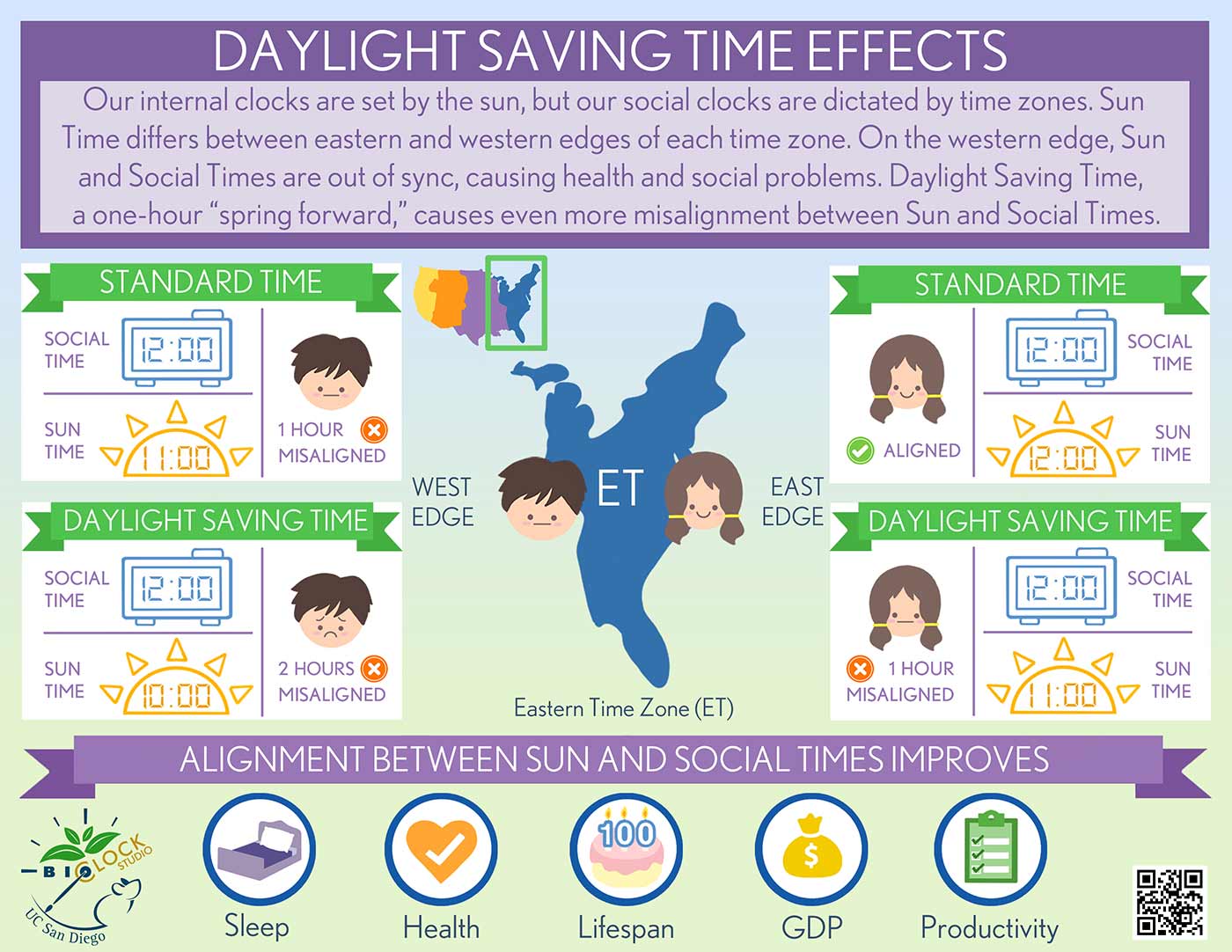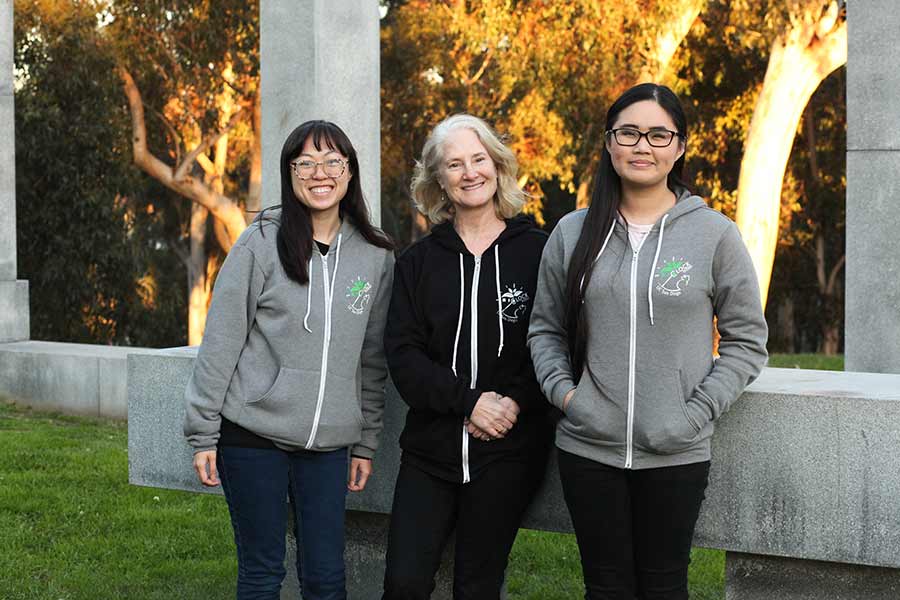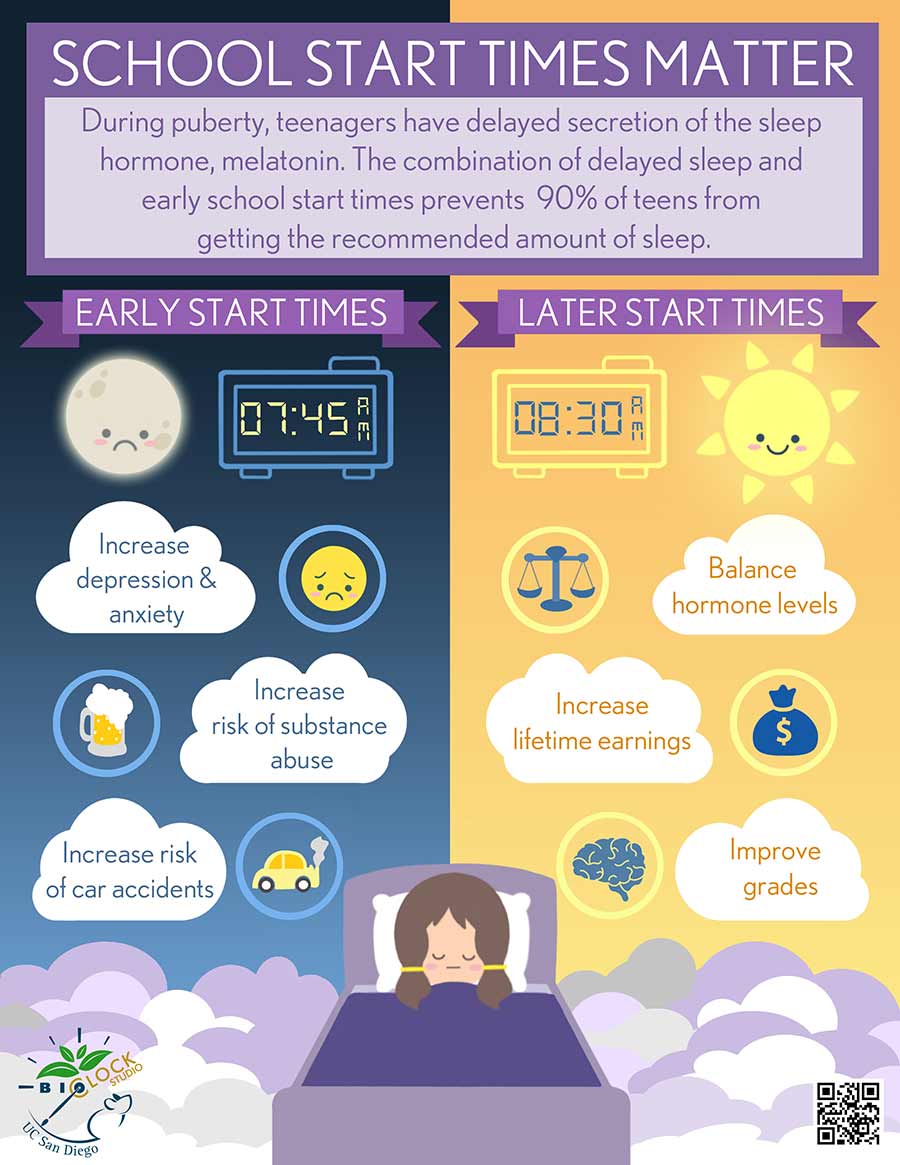
By:
- Mario Aguilera
Published Date
By:
- Mario Aguilera
Share This:
Waking Up to Why Sleep Health Matters
UC San Diego students, scientists drive new initiative aimed at helping the public ‘see the light’ on circadian rhythms and sleep health
At the start of the day, we all do it. We reflexively reach for our phones. As the day winds down, many of us can’t help but do the same. We lie in bed as the luminous glow of our phones—along with TVs and tablets, in many cases—shines into our eyes.
In the modern age of technological gadgetry, light—both natural and artificial—is pervasive. Light is inherently intertwined with the 24-hour biological sleep-wake cycle known as the circadian rhythm, as well as with the quality of our sleep, which factors into our health, disease prevention and normal everyday functioning.

Credit: Ximei Ackerman, Tiffany Phan, Maryanna Sophia Landaverde, Stuart Lee, Adam Seluzicki, and Susan Golden.
As daylight saving time ends this weekend and we reset the clocks to “fall back” once again, scientists around the world and students at UC San Diego want you to know more about the science of circadian rhythms and why it’s so crucial to our health and well-being.
Bucking traditional methods of science dissemination, they are no longer content to issue scientific papers and hope they somehow resonate with the public. Rather, they are taking a proactive role in informing and educating the public with a range of new outreach tools: videos, animations, infographics and social media designed to communicate the science of sleep as never before.
These materials come equipped with firm, research-backed positions on key issues involving circadian rhythms with far-reaching implications, ranging from the future of daylight saving time (spoiler alert: scientists recommend year-round standard time) to determining the time students start their school day (later is definitely better!).
A New Awakening
Several years ago, UC San Diego Biological Sciences Distinguished Professor Susan Golden and her husband, Professor James Golden, decided they wouldn’t tolerate rogue bursts of light into their bedroom any longer. As part of an effort to improve their personal “circadian hygiene,” they installed programmable black-out shades as a barrier against any stray light disrupting their nighttime slumber and to prevent premature morning awakenings. Golden also wears orange-tinted glasses before going to bed to block certain wavelengths of light and help ease the transition to sleep. In hotels, she and James do their best to smother the various streams of light pulsing around their rooms. And instead of sitting in a car during their morning commute, the Goldens have switched to riding electric bikes, which has increased their daily exposure to crucial early morning sunlight, a change that she swears makes her feel great these days.
As director of UC San Diego’s Center for Circadian Biology and a member of the international Society for Research on Biological Rhythms (SRBR), such issues have been thrust front and center in her professional life as well.
Two years ago, Golden and other SRBR scientists made an important decision to improve their connections with the public. The science produced by the society’s members, they decided, was too valuable to keep ensconced within their scientific circles.

UC San Diego Distinguished Professor Susan Golden (center) with BioClock Studio students Tiffany Phan and Ximei Ackerman Credit: Ryan Lagrand
“This was a big step forward by a community that realizes the research that has been conducted has the potential for real impact on society, including public health, productivity and the economy,” said Golden.
Traditionally, scientists gather data, publish papers and hope that the results make an impact. Often, little is done to transfer the knowledge to the public arena or engage lay audiences.
“We are typically not comfortable taking leaps beyond the data we already have,” said Golden. “So the decision by SRBR was made to take a leap because if we don’t, others who have commercial interests in circadian rhythm issues will. As a community, we believe that if we don’t act now, people will suffer unnecessarily.”
Celine Vetter, an assistant professor at the University of Colorado, Boulder, and the chair of SRBR’s public outreach committee, said the society’s public-facing makeover included reinventing its website with external audiences in mind, as well as a Twitter-based campaign full of circadian biology-relevant tweets. They also began developing position papers, not only addressing school start times and the consequences of daylight saving time, but also on how light affects your body clock, when we should (and should not) eat during the day and the best times to take your medications.
“We realized most of our online material was geared to the scientific community rather than translating the research we do towards the general public,” said Vetter. “We realized that we need to be more vocal and make sure our knowledge gets out there. A lot of our work is relevant to policymakers, so making sure we are heard is a big responsibility.”
Let There Be Light
Backed by a five-year grant from the Howard Hughes Medical Institute, Golden launched an effort to bring UC San Diego students into the challenging arena of circadian rhythm science communication.
Drawing from a diverse pool of disciplines, the effort was designed to have students work with faculty and postdoctoral scholars in the Center for Circadian Biology to produce creative public educational materials. Thus, the BioClock Studio course was born. The multimedia products of the BioClock Studio have transformed another 300-student course, taught by biology and psychology faculty, on the topic of circadian biology.
Then, the effort took another leap in 2019. Joining forces with SRBR, BioClock students began working hand-in-hand with leading circadian rhythm scientists from around the world. The students were given insider access to new position papers on key circadian rhythm topics to ensure that the BioClock Studio’s education-communication products are based on the latest, most broadly accepted science on sleep health and circadian rhythm.
“To have undergraduate students working with scientists they don’t know from around the world and become partners in getting the word out to the public—it’s pretty much unprecedented,” said Golden.
BioClock Studio alumna Ximei Ackerman took the class earlier this year and has remained involved to see her projects through completion. She has served as a graphic designer and illustrator, working on a highly iterative feedback-refinement process with her fellow students in biology, psychology and visual arts, as well as prominent scientists.
“I think it’s really cool that I get to be part of something big like this,” said Ackerman, a fourth-year student majoring in human biology. “If I can help people understand more about these issues, it’s really fulfilling and very rewarding to me. Sometimes when we see information it might be really daunting or overwhelming, but if we have something that’s easy to look at, read and understand, people can have a discussion about it—it’s something they’ll remember.”
Ackerman said the most difficult aspect was taking large circadian biology concepts and turning them into condensed but accurate forms. She said it was intimidating to work with internationally renowned scientists but relished the interactions.
“I enjoyed the challenge of balancing our vision and their vision, and molding it together to be one vision,” said Ackerman.
Student Golnesa Safavi took the BioClock Studio course earlier this year and is now working as an instructional assistant for the 300-student class that is using a tutorial she helped to create.
“Circadian biology is something that is really relatable. You can see the effects of it in everyday life. It was interesting to find out that there was a really complicated biological mechanism behind the whole thing,” said Safavi, who continues to work on BioClock products, including a video called “The Effects of Sleep Deprivation,” which highlights impacts on driving, academic performance and overall mood. “I didn’t know about how prevalent circadian biology was in my life before taking the class.”
Bright Days, Dark Nights
At the end of the day (pun intended), Golden, her students and SRBR are confident that their efforts will have a direct influence on the way people think about their circadian rhythms, whether the topic is school start times or the state of daylight saving time. Both topics are the subject of legislation coming before voters in the United States and around the world.
The experts contend that bright, sunlight-filled days and dark nights are best for circadian health, and how to achieve this pattern varies, depending on where you live. Studies support year-round standard time rather than twice-a-year switches to and from daylight saving time. Year-round daylight saving time can be harmful because of a delay in exposure to morning light, as well as the increased light people receive later in the day, when scientists recommend reducing light exposure.

Credit: Ximei Ackerman, Tiffany Phan, Allen Gee, Alisa Kim, Shahrzad Imani, David Welkie, and Susan Golden.
“We understand everybody likes summertime and we want year-round summertime, but we cannot legislate what the sun does,” said Golden.
Vetter, who conducts field research on day-night shift workers and others with sleep behavior concerns, says there is an immense “aha!” moment when people have the right information about circadian health.
“There is a general lack of knowledge of the basic principles of how our biology works and how it translates into everyday behaviors,” said Vetter.
As for school start times, later is better.
“The lack of morning light in the winter has fairly dire consequences,” said Golden. “This includes everything from the practical consequences of children standing and waiting for the bus in the dark to the health effects of getting light exposure so much later. Light exposure into the eye—in all mammals, including humans—is really important.
“I look around and I know that people have very bad habits that would not be that hard to break. These changes would improve their lives and how they feel. It would reduce their risk for disease and help their sleep patterns.”
According to Golden, our sleep health demands that we cut light well before we go to bed. But when daybreak comes… “You need to get out there and get light.”
Inspired to better communicate your science to the public? Come learn how at a Nov. 6 special guest lecture by National Public Radio science correspondent Joe Palca. Details here.
Share This:
You May Also Like
Stay in the Know
Keep up with all the latest from UC San Diego. Subscribe to the newsletter today.


